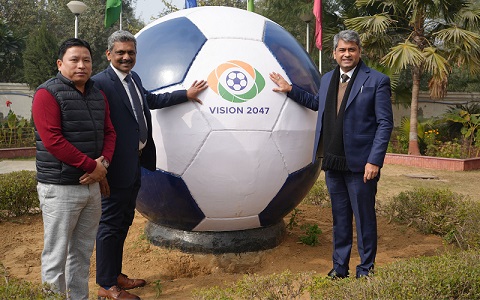
Harpal Singh Bedi
The All-India Football Federation (AIFF) on Saturday unveiled its strategic roadmap with ‘Vision 2047’ which envisages that in the country’s centenary year of independence, it will also emerge as a new powerhouse of Asian football.
The roadmap incorporates inputs from the Asian Football Confederation (AFC) and FIFA. The salient ambitions of the roadmap are to see India among the top four footballing nations in Asia, host one of the top leagues in Asia, and create a vibrant footballing ecosystem.
‘Vision 2047’ has been broken down, for diligent implementation, into six four-year strategic plans. The first of these will look to cover the period till 2026. “Vision 2047 paints a picture of where we want to position Indian Football at the outset of a hundred years of our nation’s independence,” AIFF President Kalyan Chaubey said at the event.
One of the key aspects of the roadmap is to ensure increased access to competition and games for players plying their trade in the country. By 2047, the Federation wants to ensure players will be able to play at least 55 matches across different competitions every season, he said.
“Transformation will begin at home through a reform of the organisational culture,” Secretary General Shaji Prabhakaran said, referring to a need for better governance of the game across the country. “A restructuring exercise will be carried out to streamline current operations and develop a team which adopts the industry’s best practices and is transparent in its dealings.”
“By 2036, the centenary of the Federation,” Prabhakaran said, “India will be among the top seven countries in Asia, and a strong contender to qualify for the World Cup on merit.”
The Federation recognised that while women’s football has been growing rapidly across the world, it has previously received very little attention in India. The weak ecosystem needs specific solutions to help increase participation and competency across the pyramid.
By 2026 — the period of the first strategic plan — the Federation will ensure the creation of a four-level league table pyramid, the top of which will be occupied by the Indian Women’s League (featuring 10 teams), followed by the 2nd Division (8 teams).
In addition, there will be five zonal leagues with eight teams each. In addition, a new women’s youth league structure has been proposed, which will see players across different age groups play a minimum of 14 matches. The Federation will ensure that a minimum of 20 states implement the new women’s youth structures by 2027.
On the men’s side, the current strategic plan will ensure the creation of a three-tier national league pyramid with 40 teams. The Hero Indian Super League and Hero I-League will boast of 14 teams each while the Hero I-League 2nd Division will consist of 12 teams. A state championship structure will see city and district leagues feed into the state championships.
A revamped men’s youth league structure will see the local state youth league and elite youth leagues will run simultaneously. Clubs and academies will participate in both with the winners of the state youth leagues qualifying for the Elite youth league.
The AIFF proposes to change this by creating a data driven scouting structure from the Elite Youth League System for its National Teams. Clubs will drive talent identification at grassroots unto the Elite Youth structure.
An increased focus will be put on utilising the FIFA windows across age groups to provide exposure to players in the national teams, with mega camps (two or more age groups) scheduled at least twice a year. Qualification for the FIFA U17 World Cups for Both Men and Women on merit is a key part of the agenda.
Infrastructure is key to achieving many long-term goals. The Federation has observed that there has, over the past decades, been a reduction in playgrounds in urban areas. Many top professional clubs do not yet own football infrastructure. The Federation plans to conduct a pan-India infrastructure census by 2025.
Subsequently, it will put in place policy interventions that will incentivise government authorities, football clubs, corporates, and private investors to invest in infrastructure. A grading and licensing criteria will be in place by 2024, and a mega football park will be formalised by 2026. The AIFF National Centre of Excellence will be fully functional by 2026.
HSB
